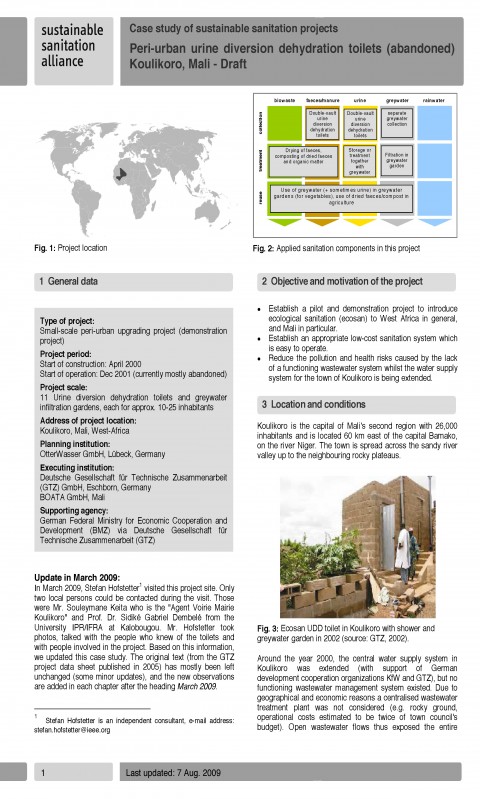Peri-urban urine diversion dehydration toilets (abandoned) Koulikoro, Mali - Draft. Case study of sustainable sanitation projects
Werner, C., Bracken, P., Schlick, J., Freese, T., Rong, W. (2009)

Published in: 2009
Publisher:
Sustainable Sanitation Alliance (SuSanA)
Author:
Werner, C., Bracken, P., Schlick, J., Freese, T., Rong, W.
Uploaded by:
SuSanA secretariat
Partner profile:
common upload
11999 Views
174 Downloads
Location of library entry
Content - Summary
This case study is about an upgrading demonstration project for peri-urban areas in Koulikoro, Mali. 11 UDDTs and greywater infiltration gardens were constructed in that project. This project was implemented by GTZ on behalf of the German Ministry BMZ.
The initial situation in Koulikoro can be described as follows: Only 3% of the households have water flush toilets and septic tanks, which are poorly designed and built. About 25% of the households are equipped with soak pits, which are mostly a hole in the street or a collection basin. All attempts to infiltrate wastewater into the ground turned out to be extremely difficult due to the high groundwater table in the vicinity of the river and the rocky underground.
Different pilot facilities, were tested. They were distinguished by:
- a separation of urine and faeces at the source
- double-vault dehydration toilets for the drying, storage and hygienisation of faeces
- a separate collection, storage and utilization of urine
- greywater treatment using planted soil filters
For urine treatment, two technologies were tested: Urine was
separated by the latrine slab surface and either ?led to a collection canister for storage followed by use, or led to a greywater garden.
Unfortunately this project has not been sustainable, mainly because institutional and financial sustainability criteria were severely neglected.
Bibliographic information
Werner, C., Bracken, P., Schlick, J., Freese, T., Rong, W. (2009). Peri-urban urine diversion dehydration toilets (abandoned) Koulikoro, Mali - Draft. Case study of sustainable sanitation projects. Sustainable Sanitation Alliance (SuSanA)
Filter tags
Case studies in SuSanA template English Peri-urban Sub-Saharan Africa Urine Urine diversion dehydration toilets (UDDTs)















